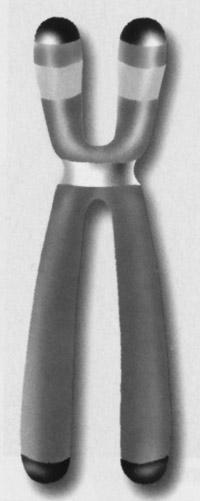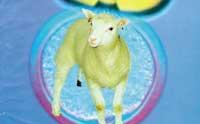Cloned clock control
2000/05/16 Roa Zubia, Guillermo - Elhuyar Zientzia
The famous Dolly was cloned from the DNA of an adult sheep. Therefore, scientists began to worry about the age of the sheep. “Are their cells older than them?” After several analyses, in 1998, they answered this question. The telomeres on the Dolly chromosomes were very short.
Telomeres are special pieces of DNA located at the ends of the chromosomes. When the cell chromosomes are copied, they lose a piece of telomere. Therefore, they act as genetic clocks. Dolly's telomeres were too short, so at birth he was genetically old. It can be said that he had the clock in advance.
Paradox of younger cows
Researchers from the Massachusetts ACT laboratory, under the direction of physicist Robert Lanza, clone animals. In times of hope they have made a surprising discovery. They say that telomeres in calves that were born are longer than normal. These cells can be copied rather than natural. The tissues obtained by this procedure can reach the same age as the original ones. Perhaps more. Certainly good news for tissue growth. But ethical problems have not disappeared.
When Lanza and his companions discovered Dolly's telomeres they began to conduct more detailed studies. They wanted to know if cloned healthy animals from old cells can be obtained. The cells of the fetuses of the calves let them copy them until they “exhaust” this capacity. Six calves were born from these cells. At birth they were larger than natural ones. They also had more blood pressure and had breathing problems. However, when they reached the age of two months they were healthy calves.
From five months of age, scientists performed cell tests. Telomeres on chromosomes were much longer than normal. The effect of cloning, in addition to the biological clock, was evident in many other features.
Lanza does not rule out that the lives of cloned animals are 50% longer. Therefore, if it really is so and was used in the case of human beings, we would reach the age of 180 years. However, the other scientists are much more cautious. It should be noted that age control is a complex process in which, in addition to the length of telomeres, other variables should be taken care of. In any case, to confirm the Lanza hypothesis it will have to be a long time, since the age of sheep and cows is usually between 12 and 20 years. Throughout this time, they should investigate biochemical control of age from another point of view.
At the moment, the differences between Dolly and Lanza's cloned cattle are not the cause. It is a mystery. This may be due to random change, different species, different cell types, or different forms of kernel transfer. For Jerry Shay, a biochemist at the Texas Southwestern Medical Center, when telomeres are very short, the cells may be able to compensate and that is why they would appear so large telomeres.
However, the results of Lanza coincide with those of other groups. In fact, Xiangzhong Yang of Conneticut University has found that in clonations from adult cow cells, the new telomeres have at least the usual length. In the cloned mouse, another group of New York researchers find the same thing.
The current challenge will be to understand the process of stretching telomeres. If what happens inside the oocyte can be repeated in vitro, the passage of the embryo can be avoided. This would allow the growth of tissue and substitute organs without creating any ethical problems.
Each country must adapt legislation for the times of rapidly approaching cloning.

Gai honi buruzko eduki gehiago
Elhuyarrek garatutako teknologia






